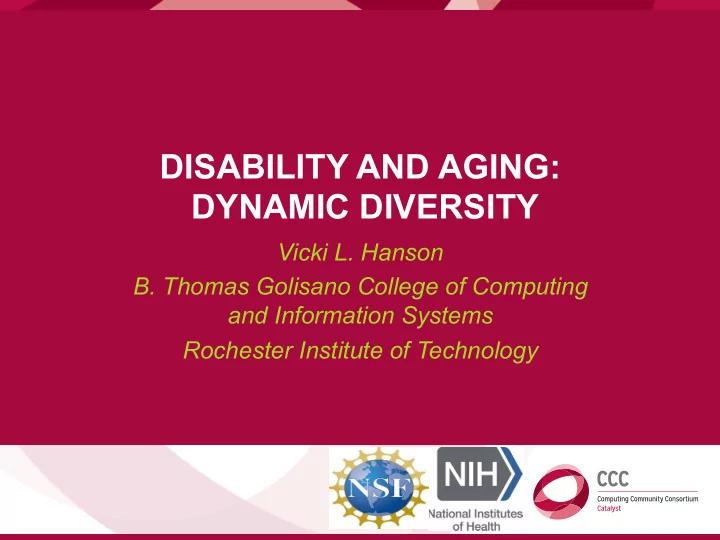

DISABILITY AND AGING: DYNAMIC DIVERSITY Vicki L. Hanson B. Thomas Golisano College of Computing and Information Systems Rochester Institute of Technology
QUESTION: Computing has made significant advances that allow for an ever-increasing amount of information capture and storage about people’s activities. What makes sense to do? And is privacy a thing of the past?
COMPUTING POWER HAS RADICALLY IMPROVED • Wearable sensors • Processing capacity • Network bandwidth • Storage capacity
LIFELOGGING • New advances underlie lifelogging – Recollect events (episodic memory); help recall names – Reminisce (emotions) with others – Reflection of life experiences • Verdict is still out – Little demonstrated benefit in real life – Still hard to access • What do people find valuable? • How might this be useful with dementia? Sellen & Whittaker (2010)
QUESTION: Given multiple and interacting age-related disabilities, how do we design for usable technology interactions?
DISABILITY
AGE 15 – 24
AGE 24 -25
AGE 35 - 44
AGE 45 - 54
AGE 54 - 66
AGE 65 - 74
AGE 70 - 74
AGE 75+
ACCESSIBILITY – DYNAMIC DIVERSITY 1. Disabilities co-occur with age – Combined effect is worse than the two separately – Sensory, physical and cognitive impairment interact • Communication • Independence / navigation 2. Designing for the ‘brightest and the best’ – How widely adopted can these be? 3. Design for young, congenitally disabled individuals – Disability that develops in old age is not the same
SPECIFIC CASE: ANALOG PHONES TO NEXT GENERATION IP NETWORKS • Analog phones are familiar, reliable and accessible (usable) • “Digital Divide” in reported smartphone usage – 79% of younger adults own smartphones (ages 18 – 24) – 18% of older adults own smartphones (age 65+) • Also a divide for those who use analog TTY telecommunications for people with hearing loss and speech impairments – Users of analog communications averaged 10 years older the population census • Current saturation: those who know ASL and have broadband – Analog TTY is those who can’t use – Low resource – Underserved
QUESTION: How do we take advantage of technology without overwhelming its users?
USEFUL AND USEABLE • Does technology do something people want? – Staying in own home may be a tipping point – But if this creates situations causing loneliness fear and is it acceptable? • Would technology mean fewer visits? • “What if I’m sick and the device doesn’t work?” – Lack of interest
CO-DESIGN
USEFUL AND USEABLE • How do older users deal with constant updating? – Migration to IP telecommunications – Constant versioning updates • Learning • Cost – Little interest among developers in supporting back-level devices or applications
QUESTION: In the future, “older adults” will have different technology experiences than those of today’s older adults. Technologies also will be different. Can we create principles for ‘future proofing’ rather than designing only for challenges of today’s older population?
Recommend
More recommend